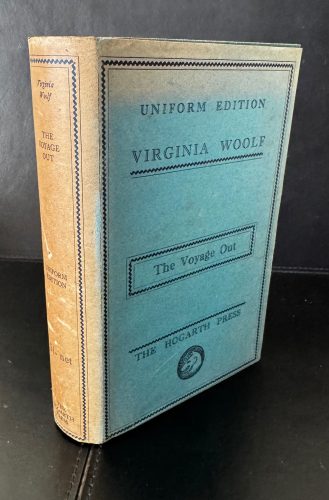
Scarce with the wrapper in collectable condition
Woolf, Virginia ~ The Voyage Out
First UK Printing (Uniform Edition) : The Hogarth Press, London : 1929
First UK Printing (Uniform Edition) published by The Hogarth Press, London in 1929. 8vo., dark green publisher’s cloth, lettered in gilt to spine; together in the plain blue printed wrapper with decorative borders and publisher’s device to upper panel (priced 5/- net to spine); The BOOK is in Very Good++ condition, the boards bright and unfaded (often found with the backstrip sunned); lightly bumped at extremities and spotted to the edges, more-so the lower edges; the endpapers offset; with a neat previous contemporary ownership inscription to the front blank end-paper; slight shelf lean; one or two spots encroaching onto outer margins of text, but otherwise clean and bright; the Very Good++ WRAPPER uniformly toned to the folds, spine and less so the upper front panel; with one small scratch along the backstrip. The wrapper is protected in a removable Brodart archival cover. First Uniform edition, with the trade edition originally published in 1915. Work on Virginia Woolf’s first novel began as early as 1907, and was written at a particularly complex and vulnerable time in the author’s life. It was the strain of writing, as well as the exhausting process of submitting work to external publishers, which contributed to a period of prolonged depression, and eventually led to her and her husband Leonard setting up The Hogarth Press, from which the bulk of her output would later be published. When The Voyage Out was released by Duckworth, the result was a haunting tale, following a couple, Mr and Mrs Ambrose, who travel with their niece from London to South America by boat. Woolf was 33 yrs old at the time it was published, and had already been writing for some ten years, but it was in this first book that she demonstrated the steam-of-consciousness narrative style, and focus on women’s relationships, which would so dominate her later work. She had also been inspired by a trip she took to Portugal in 1905, an experience echoed in the opening pages of the work: “Now a tremor ran through the table, and a light outside swerved. At the same time an electric bell rang sharply again and again. ‘We’re off,’ said Ridley.” By April 1917, just two years later, the Woolfs began printing on their own dining table at Hogarth House, and thus named their press The Hogarth Press. “…she wanted many more things than the love of one human being – the sea, the sky. She turned again and looked at the distant blue, which was so smooth and serene where the sky met the sea; she could not possibly want only one human being.” Scarce with the wrapper in collectable condition.
BINDING: Hardcover
CONDITION: Very Good++
JACKET: Very Good++
£350



